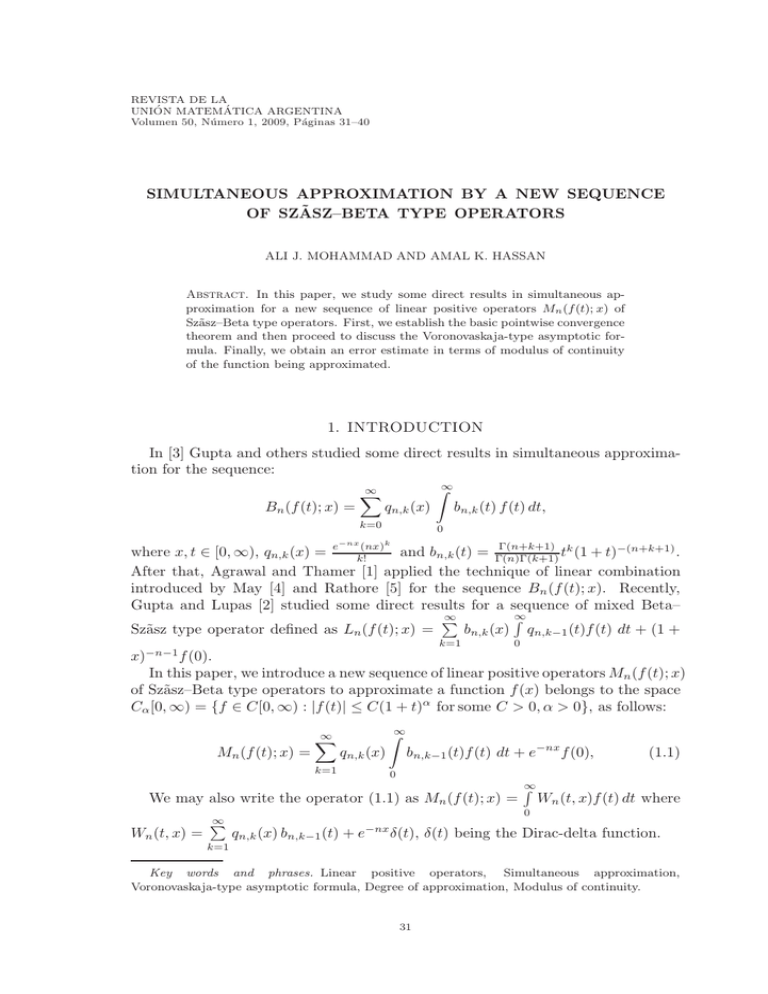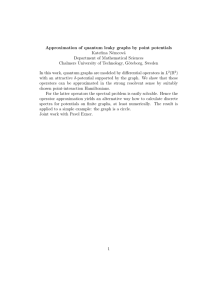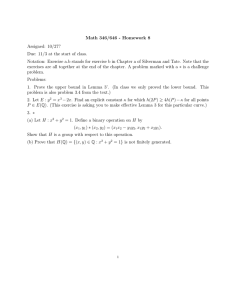Inglés
advertisement

REVISTA DE LA
UNIÓN MATEMÁTICA ARGENTINA
Volumen 50, Número 1, 2009, Páginas 31–40
SIMULTANEOUS APPROXIMATION BY A NEW SEQUENCE
OF SZÃSZ–BETA TYPE OPERATORS
ALI J. MOHAMMAD AND AMAL K. HASSAN
Abstract. In this paper, we study some direct results in simultaneous approximation for a new sequence of linear positive operators Mn (f (t); x) of
Szãsz–Beta type operators. First, we establish the basic pointwise convergence
theorem and then proceed to discuss the Voronovaskaja-type asymptotic formula. Finally, we obtain an error estimate in terms of modulus of continuity
of the function being approximated.
1. INTRODUCTION
In [3] Gupta and others studied some direct results in simultaneous approximation for the sequence:
Z∞
∞
X
bn,k (t) f (t) dt,
Bn (f (t); x) =
qn,k (x)
k=0
−nx
0
k
Γ(n+k+1) k
t (1 + t)−(n+k+1) .
where x, t ∈ [0, ∞), qn,k (x) = e k!(nx) and bn,k (t) = Γ(n)Γ(k+1)
After that, Agrawal and Thamer [1] applied the technique of linear combination
introduced by May [4] and Rathore [5] for the sequence Bn (f (t); x). Recently,
Gupta and Lupas [2] studied some direct results for a sequence of mixed Beta–
∞
R∞
P
bn,k (x) qn,k−1 (t)f (t) dt + (1 +
Szãsz type operator defined as Ln (f (t); x) =
k=1
0
x)−n−1 f (0).
In this paper, we introduce a new sequence of linear positive operators Mn (f (t); x)
of Szãsz–Beta type operators to approximate a function f (x) belongs to the space
Cα [0, ∞) = {f ∈ C[0, ∞) : |f (t)| ≤ C(1 + t)α for some C > 0, α > 0}, as follows:
Mn (f (t); x) =
∞
X
k=1
qn,k (x)
Z∞
bn,k−1 (t)f (t) dt + e−nx f (0),
We may also write the operator (1.1) as Mn (f (t); x) =
Wn (t, x) =
∞
P
(1.1)
0
R∞
Wn (t, x)f (t) dt where
0
qn,k (x) bn,k−1 (t) + e−nx δ(t), δ(t) being the Dirac-delta function.
k=1
Key words and phrases. Linear positive operators, Simultaneous approximation,
Voronovaskaja-type asymptotic formula, Degree of approximation, Modulus of continuity.
31
32
ALI J. MOHAMMAD AND AMAL K. HASSAN
The space Cα [0, ∞) is normed by kf kCα = sup |f (t) | (1 + t)−α .
0≤t<∞
There are many sequences of linear positive operators with are approximate the
space Cα [0, ∞). All of them (in general) have the same order of approximation
O(n−1 ) [6]. So, to know what is the different between our sequence and the other
sequences, we need to check that by using the computer. This object is outside our
study in this paper.
Throughout this paper, we assume that C denotes a positive constant not necessarily the same at all occurrences, and [β] denotes the integer part of β.
2. PRELIMINARY RESULTS
For f ∈ C [0, ∞) the Szãsz operators are defined as Sn (f ; x) =
∞
P
qn,k (x) f
k=1
k
n
,
x ∈ [0, ∞) and for m ∈ N 0 (the set of nonnegative integers), the m-th order moment
∞
m
P
qn,k (x) nk − x .
of the Szãsz operators is defined as µn,m (x) =
k=0
LEMMA 2.1. [3] For m ∈ N 0 , the function µn,m (x) defined above, has the
following properties:
(i) µn,0 (x) = 1 , µn,1 (x) = 0 , and the recurrence relation is
nµn,m+1 (x) = x µ′n,m (x) + mµn,m−1 (x) , m ≥ 1;
(ii) µn,m (x) is a polynomial in x of degree at most [m/2];
(iii) For everyx ∈ [0, ∞),µn,m (x) = O n−[(m+1)/2] .
From above lemma, we get
∞
X
qn,k (x)(k − nx)2j = n2j µn,2j (x) − (−x)2j e−nx
k=1
= n2j
O(n−j ) + O(n−s )
= O(nj )
(2.1)
(for any s > 0)
(if s ≥ j).
0
For m ∈ N , the m-th order moment Tn,m (x) for the operators (1.1) is defined
as:
m
Tn,m (x) = Mn ((t − x) ; x) =
∞
X
k=1
qn,k (x)
Z∞
bn,k−1 (t)(t − x)m dt + (−x)m e−nx .
0
LEMMA 2.2.For the function Tn,m (x), we have Tn,0 (x) = 1 , Tn,1 (x) =
Tn,2 (x) =
2
nx +2nx+2x
(n−1)(n−2)
2
x
n−1 ,
and there holds the recurrence relation:
′
(n − m − 1)Tn,m+1 (x) = xTn,m
(x) + ((2x + 1)m + x) Tn,m (x)
+ mx(x + 2)Tn,m−1 (x),
Further, we have the following consequences of Tn,m (x):
Rev. Un. Mat. Argentina, Vol 50-1
(2.2)
n > m + 1.
33
SIMULTANEOUS APPROXIMATION BY A NEW SEQUENCE
(i)
(ii)
Tn,m (x) is a polynomial in x of degree exactly m;
For every x ∈ [0, ∞) , Tn,m (x) = O n−[(m+1)/2] .
Proof: By direct computation, we have Tn,0 (x) = 1, Tn,1 (x) =
2
nx +2nx+2x
(n−1)(n−2)
Tn,2 (x) =
x ∈ (0, ∞), we have
′
Tn,m
(x)
=
∞
X
2
x
n−1
and
. Next, we prove (2.2). For x = 0 it clearly holds. For
′
qn,k
(x)
k=1
Z∞
bn,k−1 (t)(t − x)m dt − n (−x)m e−nx − mTn,m−1 (x).
0
′
Using the relations xqn,k
(x) = (k−nx) qn,k (x) and t (1+t) b′n,k (t) = (k − (n + 1) t) ×
bn,k (t), we get:
′
xTn,m
(x)
=
∞
X
(k − nx) qn,k (x)
k=1
=
∞
X
Z∞
bn,k− 1 (t)(t − x)m dt + n(−x)m+1 e−nx − mxTn,m−1 (x)
0
qn,k (x)
k=1
Z∞
t(1 + t) b′n,k−1 (t)(t − x)m dt + (n + 1)Tn,m+1 (x) − (−x)m+1 e−nx
0
+ (x + 1)Tn,m (x) − (x + 1)(−x)m e−nx − mxTn,m−1 (x).
By using the identity t(1 + t) = (t − x)2 + (1 + 2x)(t − x) + x(1 + x), we have
′
xTn,m
(x) =
∞
X
qn,k (x)
k=1
Z∞
b′n,k−1 (t) (t − x)m+2 dt + (1 + 2x)
∞
X
qn,k (x)
k=1
0
+ x(1 + x)
∞
X
qn,k (x)
k=1
Z∞
Z∞
b′n,k−1 (t)(t − x)m+1 dt
0
b′n,k−1 (t)(t − x)m dt + (n + 1)Tn,m+1 (x)
0
+ (1 + x)Tn,m (x) − mxTn,m−1 (x) − (−x)m e−nx .
Integrating by parts, we get
′
(x) = (n − m − 1) Tn,m+1 (x) − (m + x + 2mx) Tn,m (x) − mx(x + 2) Tn,m−1 (x)
xTn,m
from which (2.2) is immediate.
From the values of Tn,0 (x) and Tn,1 (x), it is clear that the consequences (i) and
(ii) hold for m = 0 and m = 1. By using (2.2) and the induction on m the proof of
consequences (i) and (ii) follows, hence the details are omitted.
From the above lemma, we have
∞
X
k=1
qn,k (x)
Z∞
bn,k−1 (t)(t − x)2r dt = Tn,2r − (−x)2r e−nx
(2.3)
0
= O(n−r ) + O(n−s )
= O(n
−r
)
(for any s > 0)
(if s ≥ r).
Rev. Un. Mat. Argentina, Vol 50-1
34
ALI J. MOHAMMAD AND AMAL K. HASSAN
LEMMA 2.3. Let δand γ be any two positive real numbers and [a, b] ⊂ (0, ∞).
Then, for any s > 0, we have
Z
= O(n−s ).
Wn (t, x) tγ dt |t−x|≥δ
C[a,b]
Making use of Schwarz inequality for integration and then for summation and
(2.3), the proof of the lemma easily follows.
LEMMA 2.4. [3] There exist polynomials Qi,j,r (x) independent of n and k
such that
P
d
.
ni (k − nx)j Qi,j,r (x) qn,k (x), where D = dx
xr Dr (qn,k (x)) =
2i + j ≤ r
i, j ≥ 0
3. MAIN RESULTS
(r)
Firstly, we show that the derivative Mn (f (t); x) is an approximation process
for f (r) (x) , r = 1 , 2 , . . ..
Theorem 3.1. If r ∈ N , f ∈ Cα [0, ∞) for some α > 0 and f (r) exists at a
point x ∈ (0, ∞), then
lim Mn(r) (f (t); x) = f (r) (x).
n→∞
(3.1)
Further, if f (r) exists and is continuous on (a − η, b + η) ⊂ (0, ∞) , η > 0, then
(3.1) holds uniformly in [a, b].
Proof: By Taylor’s expansion of f , we have
f (t) =
r
X
f (i) (x)
i=0
i!
(t − x)i + ε(t, x)(t − x)r ,
where, ε(t, x) → 0 as t → x. Hence
∞
Mn(r)
(f (t); x) =
Z
r
X
f (i) (x)
i=0
i!
0
Wn(r) (t, x)(t
i
− x) dt +
Z∞
Wn(r) (t, x) ε(t, x) (t − x)r dt
0
:= I1 + I2 .
Now, using Lemma 2.2 we get that Mn (tm ; x)is a polynomial in x of degree
exactly
, for all m ∈ N 0 . Further , we can write it as:
Mn (tm ; x) =
(n − m − 1)! nm m (n − m − 1)! nm−1
x +
m(m − 1) xm−1 + O(n−2 ). (3.2)
(n − 1)!
(n − 1)!
Therefore,
Rev. Un. Mat. Argentina, Vol 50-1
35
SIMULTANEOUS APPROXIMATION BY A NEW SEQUENCE
«
Z∞
i „
r
X
f (i) (x) X i
(−x)i−j Wn(r) (t, x) tj dt
j
i!
j=0
i=0
0
«
„
«
„
(r)
f (x) (n − r − 1)! r
(n − r − 1)! r
=
n r! = f (r) (x)
n
→ f (r) (x) as n → ∞.
r!
(n − 1) !
(n − 1) !
I1 =
Next, making use of Lemma 2.4 we have
|I2 | ≤
X
2i + j ≤ r
i, j ≥ 0
|Qi,j,r (x)|
ni
xr
∞
X
j
qn,k (x) |k − nx|
k=1
Z∞
bn,k−1 (t) |ε(t, x)| |t − x|r dt
0
+ (nx)r e−nx |ε(0, x)|
:= I3 + I4 .
Since ε(t, x) → 0 as t → x, then for a given ε > 0, there exists a δ > 0 such
that |ε(t, x)| < ε, whenever 0 < |t − x| < δ. For |t − x| ≥ δ, there exists a constant
C > 0 such that |ε(t, x)(t − x)r | ≤ C |t − x|γ .
|Qi,j,r (x)|
:= M (x) = C ∀ x ∈ (0, ∞). Hence,
Now, since
sup
xr
2i + j ≤ r
i, j ≥ 0
I3 ≤ C
X
2i + j ≤ r
i, j ≥ 0
ni
∞
X
k=1
j
qn,k (x) |k − nx|
Z
r
bn,k−1 (t) ε |t − x| dt
|t−x|<δ
+
Z
|t−x|≥δ
:= I5 + I6 .
γ
bn,k−1 (t) |t − x| dt
Now, applying Schwartz inequality for integration and then for summation, (2.1)
and (2.3) we led to
Rev. Un. Mat. Argentina, Vol 50-1
36
ALI J. MOHAMMAD AND AMAL K. HASSAN
I5 ≤ ε C
X
n
i
∞
X
k=1
2i + j ≤ r
i, j ≥ 0
j
0
qn,k (x) |k − nx| @
Z∞
0
11/2 0
bn,k−1 (t) dtA
@
Z∞
0
11/2
2r
bn,k−1 (t)(t − x) dtA
(since
Z∞
bn,k−1 (t) dt = 1)
0
≤ εC
X
ni
∞
X
qn,k (x)(k − nx)2j
k=1
2i + j ≤ r
i, j ≥ 0
X
≤ ε C O(n−r/2 )
!1/2 0
@
∞
X
qn,k (x)
k=1
Z∞
0
11/2
bn,k−1 (t)(t − x)2r dtA
ni O(nj/2 ) = ε O(1).
2i + j ≤ r
i, j ≥ 0
Again using Schwarz inequality for integration and then for summation, in view
of (2.1) and Lemma 2.3, we have
I6 ≤ C
X
ni
2i + j ≤ r
i, j ≥ 0
≤C
X
ni
X
i
n
2i + j ≤ r
i, j ≥ 0
X
−s
≤ O(n )
Z
qn,k (x) |k − nx|j
bn,k−1 (t) |t − x|γ dt
k=1
|t−x|≥δ
∞
X
11/2 0
0∞
Z
B
qn,k (x) |k − nx|j @ bn,k−1 (t) dtA
@
k=1
2i + j ≤ r
i, j ≥ 0
≤C
∞
X
∞
X
0
2j
qn,k (x)(k − nx)
k=1
ni O(nj/2 )
2i + j ≤ r
i, j ≥ 0
“
”
= O nr/2−s = o(1)
!1/2
Z
11/2
|t−x|≥δ
0
∞
BX
qn,k (x)
@
k=1
Z
|t−x|≥δ
C
bn,k−1 (t)(t − x)2γ dtA
2γ
bn,k−1 (t)(t − x)
11/2
C
dtA
(for any s > 0)
(for s > r/2).
Now, since ε > 0 is arbitrary, it follows that I3 = o(1). Also, I4 → 0 as n → ∞
and hence I2 = o(1), combining the estimates of I1 and I2 , we obtain (3.1).
To prove the uniformity assertion, it sufficient to remark that δ(ε) in above proof
can be chosen to be independent of x ∈ [a, b] and also that the other estimates holds
uniformly in [a, b].
Our next theorem is a Voronovaskaja-type asymptotic formula for the operators
(r)
Mn (f (t); x) , r = 1 , 2 , . . . .
Rev. Un. Mat. Argentina, Vol 50-1
SIMULTANEOUS APPROXIMATION BY A NEW SEQUENCE
37
THEOREM 3.2. Let f ∈ Cα [0, ∞) for some α > 0. If f (r+2) exists at a point
x ∈ (0, ∞) , then
“
”
r(r + 1) (r)
f (x) + ((r + 1)x + r)f (r+1) (x)
(3.3)
lim n Mn(r) (f (t); x) − f (r) (x) =
n→0
2
1
+ x(x + 2) f (r+2) (x).
2
Further, if f (r+2) exists and is continuous on the interval (a − η, b + η) ⊂ (0, ∞), η > 0,
then (3.3) holds uniformly on [a, b].
Proof: By the Taylor’s expansion of f (t), we get
Mn(r) (f (t); x) =
r+2 (i)
X
f (x)
i=0
i!
:= I1 + I2 ,
Mn(r) (t − x)i ; x + Mn(r) ε(t, x)(t − x)r+2 ; x
where ε(t, x) → 0as t → x.
By Lemma 2.2 and (3.2), we have
I1 =
«
r+2 (i)
i „
X
f (x) X i
(−x)i−j Mn(r) (tj ; x)
j
i!
i=r
j=r
”
f (r+1) (x) “
f (r) (x) (r) r
(r + 1)(−x)Mn(r) (tr ; x) + Mn(r) (tr+1 ; x)
Mn (t ; x) +
r!
(r + 1)!
„
«
(r+2)
f
(x) (r + 2)(r + 1) 2 (r) r
+
x Mn (t ; x) + (r + 2)(−x)Mn(r) (tr+1 ; x) + Mn(r) (tr+2 ; x)
(r + 2)!
2
„
«
(n − r − 1)!nr
(r)
= f (x)
(n − 1)!
«
„
f (r+1) (x)
(n − r − 1) !nr
r!
+
(r + 1)(−x)
(r + 1)
(n − 1) !
«ff
„
r+1
(n − r − 2) !nr
(n − r − 2) !n
(r + 1)!x +
(r + 1)r r !
+
(n − 1) !
(n − 1) !
„
«
f (r+2) (x) (r + 1)(r + 2) 2 (n − r − 1) !nr
x
r!
+
(r + 2)!
2
(n − 1)!
„„
«
„
«
«
(n − r − 2) !nr+1
(n − r − 2)!nr
+ (r + 2)(−x)
(r + 1) !x +
(r + 1) !r
(n − 1) !
(n − 1) !
«ff
„
(n − r − 3) !nr+2 (r + 2)! 2 (n − r − 3) !nr+1
.
x +
(r + 2)(r + 1)(r + 1) !x
+ O(n−2 ).
+
(n − 1) !
2
(n − 1) !
=
Hence in order to prove (3.3) it suffices to show that nI2 → 0 as n → ∞, which
follows on proceeding along the lines of proof of I2 → 0 as n → ∞ in Theorem 3.1.
The uniformity assertion follows as in the proof of Theorem 3.1.
Finally, we present a theorem which gives as an estimate of the degree of ap(r)
proximation by Mn (.; x) for smooth functions.
Rev. Un. Mat. Argentina, Vol 50-1
38
ALI J. MOHAMMAD AND AMAL K. HASSAN
THEOREM 3.3. Let f ∈ Cα [0, ∞) for some α > 0 and r ≤ q ≤ r + 2. If
f (q) exists and is continuous on (a − η, b + η) ⊂ (0, ∞) , η > 0, then for sufficiently
large n,
‚
‚
‚ (r)
‚
(r)
‚Mn (f (t); x) − f (x)‚
C[a,b]
≤ C1 n−1
q ‚
‚
X
‚ (i) ‚
‚f ‚
i=r
C[a,b]
“
”
+C2 n−1/2 ωf (q) n−1/2 +O(n−2 )
where C1 , C2 are constants independent of f and n, ωf (δ) is the modulus of continuity of f on (a − η, b + η), and k . kC[a,b] denotes the sup-norm on [a, b] .
Proof. By Taylor’s expansion of f , we have
f (t) =
q
X
f (i) (x)
i!
i=0
(t − x)i +
f (q) (ξ) − f (q) (x)
(t − x)q χ(t) + h(t, x)(1 − χ(t)),
q!
where ξ lies between t, x, and χ(t) is the characteristic function of the interval
(a − η, b + η). Now,
0
1
Z∞
q
(i)
X
f
(x)
Mn(r) (f (t); x) − f (r) (x) = @
Wn(r) (t, x)(t − x)i dt − f (r) (x)A
i!
i=0
0
+
Z∞
Wn(r) (t, x)
f
(q)
(ξ) − f
q!
(q)
0
(x)
ff
Z∞
(t − x) χ(t) dt + Wn(r) (t, x)h(t, x)(1 − χ(t)) dt
q
0
:= I1 + I2 + I3 .
By using Lemma 2.2 and (3.2), we get
I1 =
„
«
q
i „
X
(n − j − 1)! nj j
dr
f (i) (x) X i
x
(−x)i−j r
j
i!
dx
(n − 1)!
j=r
i=r
+
«
(n − j − 1)! nj−1
j(j − 1)xj−1 + O(n−2 ) − f (r) (x).
(n − 1)!
Consequently,
kI1 kC[a,b] ≤ C1 n
−1
q X
(i) f i=r
C[a,b]
!
+ O(n−2 ), uniformly on [a, b].
To estimate I2 we proceed as follows:
(
)
Z∞ f (q) (ξ) − f (q) (x)
(r)
q
|I2 | ≤
|t − x| χ(t) dt
Wn (t, x) q!
0
ωf (q) (δ)
≤
q!
Z∞ |t − x|
(r)
q
|t − x| dt
W
(t,
x)
1
+
n
δ
0
Rev. Un. Mat. Argentina, Vol 50-1
SIMULTANEOUS APPROXIMATION BY A NEW SEQUENCE
39
"∞
Z∞
ωf (q) (δ) X
(r)
q
q+1
dt
≤
qn,k (x) bn,k−1 (t) |t − x| + δ −1 |t − x|
q!
k=1
0
+ (−n)r e−nx (xq + δ −1 xq+1 )
, δ > 0.
Now, for s = 0 , 1 , 2 , . . . , using Schwartz inequality for integration and then
for summation, (2.1) and (2.3), we have
∞
X
qn,k (x) |k − nx|j
k=1
Z∞
bn,k−1 (t) |t − x|s dt ≤
∞
X
k=1
0
80 ∞
1 1/2
< Z
j
@
qn,k (x) |k − nx|
bn,k−1 (t)dtA
:
0
(3.4)
11/2 9
0∞
>
Z
=
×@ qn,k−1 (t)(t − x)2s dtA
>
;
0
11/2
!1/2 0 ∞
Z∞
∞
X
X
2s A
2j
@
qn,k (x)(k − nx)
qn,k (x) bn,k−1 (t)(t − x) dt
≤
k=1
= O(n
k=1
j/2
)O(n
−s/2
0
)
= O(n(j−s)/2 ), uniformly on[a, b].
Therefore, by Lemma 2.4 and (3.4), we get
∞ ˛
∞
˛ Z∞
X
X
˛ (r)
˛
bn,k−1 (t) |t − x|s dt ≤
˛qn,k (x) ˛
k=1
k=1
0
ni |k − nx|j
X
2i + j ≤ r
i, j ≥ 0
|Qi,j,r (x) |
qn,k (x)
xr
×
Z∞
(3.5)
bn,k−1 (t) | t − x|s dt
0
0
B
B
sup
≤B
B
@ 2i + j ≤ r
i, j ≥ 0
=C
X
1
sup
x∈[a,b]
C
|Qi,j,r (x)| C
C
C
xr
A
X
i
2i + j ≤ r
i, j ≥ 0
0
n @
∞
X
qn,k (x) |k − nx|
j
k=1
Z∞
0
s
bn,k−1 (t) |t − x| dt A
ni O(n(j−s)/2 ) = O(n(r−s)/2 ), uniformly on [a, b] .
2i + j ≤ r
i, j ≥ 0
(since
sup
2i + j ≤ r
i, j ≥ 0
sup
x∈[a,b]
|Qi,j,r (x)|
xr
:= M(x) but fixed )
Choosing δ = n−1/2 and applying (3.5), we are led to
`
´
ωf (q) n−1/2 h
i
O(n(r−q)/2 ) + n1/2 O(n(r−q−1)/2 ) + O(n−m ) , (for any m > 0)
“
”
≤ C2 n−(r−q)/2 ωf (q) n−1/2 .
kI2 kC[a,b] ≤
1
q!
Rev. Un. Mat. Argentina, Vol 50-1
40
ALI J. MOHAMMAD AND AMAL K. HASSAN
Since t ∈ [0, ∞) \ (a−η, b+η), we can choose δ > 0 in such a way that |t − x| ≥ δ
for all x ∈ [a, b]. Thus, by Lemmas 2.3 and 2.4 , we obtain
|I3 | ≤
∞
X
k=1
X
ni |k − nx|j
2i + j ≤ r
i, j ≥ 0
|Qi,j,r (x)|
qn,k (x)
xr
Z
bn,k−1 (t) |h(t, x) | dt + (−n)r e−nx |h(0, x)| .
|t−x|≥δ
α
For |t − x| ≥ δ, we can find a constant C such that |h(t, x)| ≤ C |t − x| . Hence,
using Schwarz inequality for integration and then for summation ,(2.1), (2.3), it
easily follows that I3 = O(n−s ) for any s > 0, uniformly on [a, b].
Combining the estimates of I1 , I2 I3 , the required result is immediate.
References
[1] P.N. Agrawal and Kareem J. Thamer. Linear combinations of Szãsz-Baskakov type operators,
Demonstratio Math.,32(3) (1999), 575-580.
[2] Vijay Gupta and Alexandru Lupas. Direct results for mixed Beta-Szãsztype operators, General
Mathematics 13(2), (2005), 83-94.
[3] Vijay Gupta, G.S. Servastava and A. Shahai. On simultaneous approximation by Szãsz-Beta
operators, Soochow J. Math. 21, (1995), 1-11.
[4] C.P. May. Saturation and inverse theorems for combinations of a class of exponential- type
operators, Canad. J. Math. 28 (1976), 1224-1250.
[5] R.K.S. Rathore. Linear Combinations of Linear Positive Operators and Generating Relations
in Special Functions, Ph.D. Thesis, I.I.T. Delhi (India) 1973.
[6] E. Voronovskaja. Détermination de la forme asymptotique d’ápproximation des fonctions par
les polynômes de S.N. Bernstein, C.R. Adad. Sci. USSR (1932), 79-85.
Ali J. Mohammad
University of Basrah,
College of Education,
Dept of Mathematics,
Basrah, IRAQ.
alijasmoh@yahoo.com
Amal K. Hassan
University of Basrah,
College of Science,
Dept of Mathematics,
Basrah, IRAQ.
Recibido: 8 de noviembre de 2006
Aceptado: 11 de marzo de 2008
Rev. Un. Mat. Argentina, Vol 50-1



